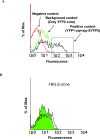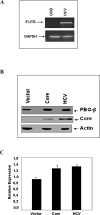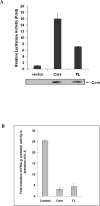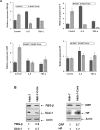Hepatitis C virus core protein interacts with fibrinogen-beta and attenuates cytokine stimulated acute-phase response
- PMID: 20162731
- PMCID: PMC5837823
- DOI: 10.1002/hep.23502
Hepatitis C virus core protein interacts with fibrinogen-beta and attenuates cytokine stimulated acute-phase response
Abstract
Fibrinogen-beta (FBG-beta), an important acute-phase protein (APP), is generated by the liver as a target for inflammatory mediators. Here we identified FBG-beta as a hepatitis C virus (HCV) core interacting protein by screening a human liver complementary DNA (cDNA) library using mammalian two-hybrid analysis. An association between FBG-beta and HCV core protein was verified by confocal microscopy and coimmunoprecipitation from the transfected human hepatocyte (Huh-7) cell line. HCV core or genomic RNA transfected Huh-7 cells modestly increased FBG-beta protein expression when compared to the basal level in control hepatocytes. Transfection of HCV core or full-length (FL) gene into Huh-7 cells up-regulated basal FBG-beta promoter activity. Exogenous addition of IL-6 stimulates FBG-beta promoter activity in hepatocytes. However, ectopic expression of HCV core or FL in hepatocytes inhibited IL-6-stimulated FBG-beta promoter activation. Inhibition of endogenous FBG-beta expression following introduction of small interfering RNA (siRNA) into cells displayed a gain of function of promoter regulation by HCV core protein. Further studies suggested that HCV core gene expression in stable transfectants of Huh-7 cells resulted in a basal up-regulation of FBG-beta and other APPs. However, treatment with cytokines, interleukin-6 (IL-6), or tumor necrosis factor-alpha repressed FBG-beta and other acute-phase response (APR) genes.
Conclusion: Our results reveal that the core/FBG-beta interaction may act as a regulatory feedback, allowing repression of IL-6-stimulated APR genes. Together, these data suggested a network of interactions between HCV core and the hepatic APR genes, and may contribute to impaired innate immunity for viral persistence.
Figures






Similar articles
-
Hepatitis C virus core protein and cellular protein HAX-1 promote 5-fluorouracil-mediated hepatocyte growth inhibition.J Virol. 2009 Oct;83(19):9663-71. doi: 10.1128/JVI.00872-09. Epub 2009 Jul 15. J Virol. 2009. PMID: 19605487 Free PMC article.
-
The functional role of an interleukin 6-inducible CDK9.STAT3 complex in human gamma-fibrinogen gene expression.J Biol Chem. 2007 Dec 21;282(51):37091-102. doi: 10.1074/jbc.M706458200. Epub 2007 Oct 23. J Biol Chem. 2007. PMID: 17956865
-
Hepatitis C virus core protein enhances NF-kappaB signal pathway triggering by lymphotoxin-beta receptor ligand and tumor necrosis factor alpha.J Virol. 1999 Feb;73(2):1672-81. doi: 10.1128/JVI.73.2.1672-1681.1999. J Virol. 1999. PMID: 9882379 Free PMC article.
-
Lipopolysaccharide and Tumor Necrosis Factor Alpha Inhibit Interferon Signaling in Hepatocytes by Increasing Ubiquitin-Like Protease 18 (USP18) Expression.J Virol. 2016 May 27;90(12):5549-5560. doi: 10.1128/JVI.02557-15. Print 2016 Jun 15. J Virol. 2016. PMID: 27009955 Free PMC article.
-
Hepatitis C virus core protein stimulates hepatocyte growth: correlation with upregulation of wnt-1 expression.Hepatology. 2005 May;41(5):1096-105. doi: 10.1002/hep.20668. Hepatology. 2005. PMID: 15841445
Cited by
-
Predictive role of acute phase reactants in the response to therapy in patients with chronic hepatitis C virus infection.Gut Liver. 2013 Jan;7(1):82-8. doi: 10.5009/gnl.2013.7.1.82. Epub 2012 Nov 13. Gut Liver. 2013. PMID: 23424009 Free PMC article.
-
A versatile ribosomal protein promoter-based reporter system for selective assessment of RNA stability and post-transcriptional control.RNA. 2010 Jun;16(6):1245-55. doi: 10.1261/rna.2026310. Epub 2010 Apr 23. RNA. 2010. PMID: 20418359 Free PMC article.
-
Immunologic, metabolic and genetic factors in hepatitis C virus infection.World J Gastroenterol. 2014 Apr 7;20(13):3443-56. doi: 10.3748/wjg.v20.i13.3443. World J Gastroenterol. 2014. PMID: 24707127 Free PMC article. Review.
-
Hepatitis C virus-mediated inhibition of cathepsin S increases invariant-chain expression on hepatocyte surface.J Virol. 2012 Sep;86(18):9919-28. doi: 10.1128/JVI.00388-12. Epub 2012 Jul 3. J Virol. 2012. PMID: 22761382 Free PMC article.
-
Hepatitis C virus infection: establishment of chronicity and liver disease progression.EXCLI J. 2014 Aug 27;13:977-96. eCollection 2014. EXCLI J. 2014. PMID: 26417315 Free PMC article. Review.
References
-
- Gabay C, Kushner I. Acute-phase proteins and other systemic responses to inflammation. N. Engl. J. Med. 1999;340:448–454. - PubMed
-
- Choy EH, Panayi GS. Cytokine pathways and joint inflammation in rheumatoid arthritis. N Engl J Med. 2001;344:907–16. - PubMed
-
- Baumann H, Gauldie J. The acute phase response. Immunol Today. 1994;15:74–80. - PubMed
-
- Black PH. The inflammatory response is an integral part of the stress response: Implications for atherosclerosis, insulin resistance, type II diabetes and metabolic syndrome X. Brain, Behav & Immun. 2003;17:350–64. - PubMed
-
- Gauldie J, Richards C, Harnish D, Lansdorp P, Baumann H. Interferon beta 2/B-cell stimulatory factor type 2 shares identity with monocyte-derived hepatocyte-stimulating factor and regulates the major acute phase protein response in liver cells. Proc. Natl. Acad. Sci. 1987;84:7251–7255. - PMC - PubMed
Publication types
MeSH terms
Substances
Grants and funding
LinkOut - more resources
Full Text Sources
Molecular Biology Databases
Miscellaneous
